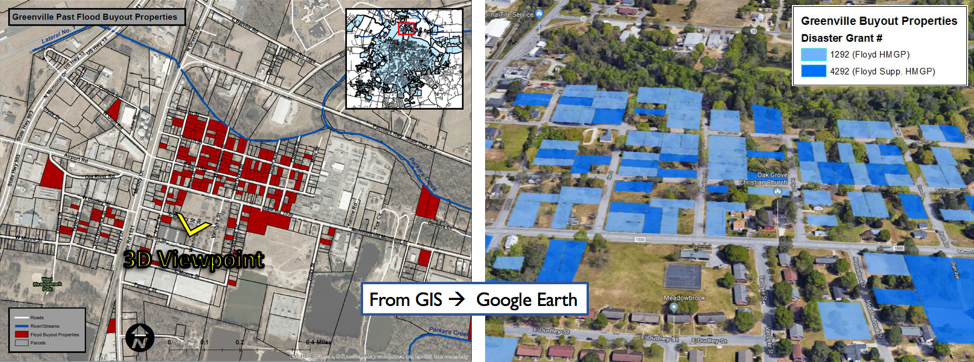Guest post by David Salvesen and Christian Kamrath
Hurricane Matthew, which struck North Carolina in October 2016, reminded us of just how vulnerable North Carolina is to flooding. Torrential rains caused severe flooding that breached levees, closed major roads and inundated entire communities. Thousands of homes in the eastern part of the state were destroyed.
Many of these same homes had flooded before, for example during Hurricanes Fran and Floyd in the late 1990s. To reduce the risks of future flooding, communities across the state have been acquiring and removing the most vulnerable homes from the floodplain. These acquisitions, known as buyouts, are funded primarily by the Federal Emergency Management Agency (FEMA). Since the 1990s, FEMA has funded the acquisition of over 20,000 homes, including some 5,000 homes in North Carolina.
Homes that are acquired with FEMA funds must be removed or demolished and the land protected in perpetuity as open space. By removing homes from harm’s way, buyouts can permanently reduce a community’s vulnerability to flooding. However, buyouts also can reduce the local tax base. Plus, local governments must cover the costs of maintaining the now-vacant properties. And since buyouts are voluntary, not all eligible homeowners participate, thus limiting the use of the acquired lands. The most common use of buyout lands is vacant lots. Although some communities have created parks, community gardens, and greenways.
The Institute for the Environment is leading a project, with colleague Todd BenDor from the UNC Department of City and Regional Planning, to carry out a study of floodplain buyouts in North Carolina. The project is funded by the NC Policy Collaboratory.
The goals of the project are to estimate the net financial impacts of buyouts on local governments in North Carolina and to explore the factors that might motivate people to participate in a buyout.
The project is examining the impact of buyouts in eight communities: Charlotte, Greenville, Kinston, Lumberton, Raleigh, Rocky Mount, Seven Springs and Windsor. These communities vary in size from Seven Springs (pop. 110) to Charlotte (pop. 842,051). Thus far, the project team has met with local officials in six communities, created GIS maps of buyout areas, and collected financial data to estimate the loss of tax base and the costs associated with maintaining the buyout properties. The project is also trying to estimate the savings, or avoided losses, the buyouts will provide the next time flooding occurs. That is, what expenses will the community not incur because the acquired homes will no longer be there to flood.

Preliminary findings suggest the financial impact of a buyout varies by community and depends on a number of factors, including:
- The nature and size of the buyout. For example, many buyouts resemble a checkerboard, with vacant homes interspersed among occupied houses. With this pattern of acquisitions, most communities simply plant grass on the vacant lots and mow regularly.
- Use of the property. Some communities have created a community amenity, such as a park, out of the acquired lands. Others simply lease the isolated, vacant lots to adjacent landowners.
- Where people go. If buyout participants leave the community, then the community suffers a loss of tax base. In many cases, participants are able to find replacement housing within the community.
- What costs get reimbursed. Federal and state grants often cover the bulk of local expenses for disaster recovery. Since the focus is on the fiscal impact of buyouts on local governments, reimbursement by state or federal government affects the calculation of avoided losses.
The project will be completed by June 30, 2018 and results are expected to be shared with relevant local government officials and other interested parties.
For more information about the buyout project, please contact David Salvesen at salvesen@unc.edu.
This post was originally published to the Institute for the Environment’s blog on May 4, 2018.
David Salvesen is a research associate with the UNC Institute for the Environment and the director of the Sustainable Triangle Field Site.
Christian Kamrath is a graduate student in the UNC Department of City and Regional Planning.




